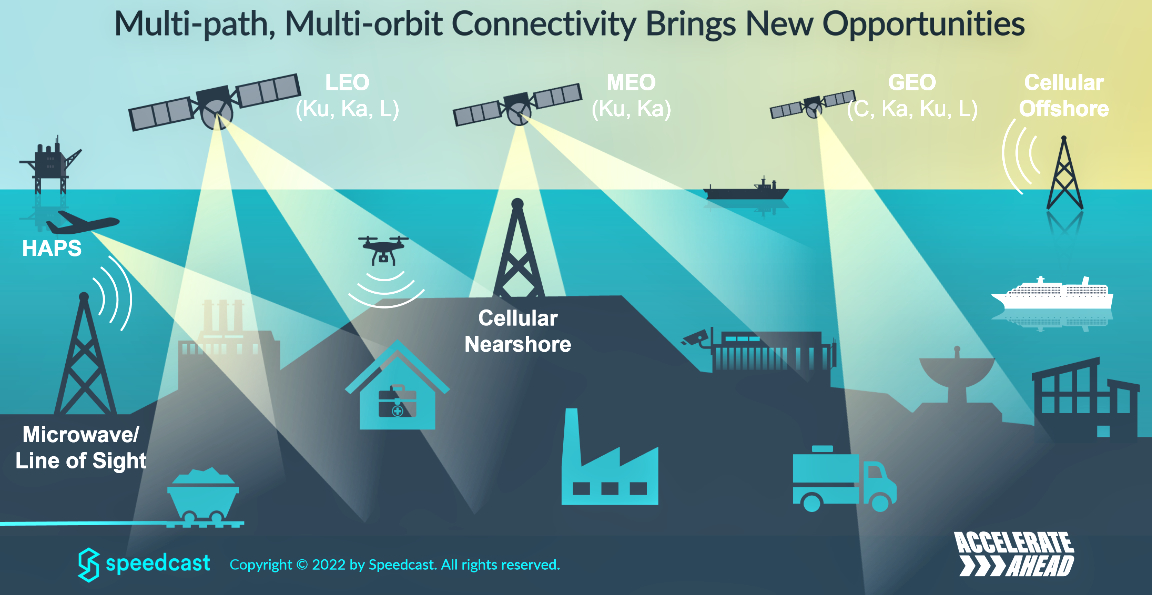From global business to everyday life, we rely more each year on reliable digital connectivity. In 2022 alone, global internet bandwidth consumption has already leaped 28% and demand shows no sign of slowing down as devices and bandwidth-heavy applications multiply in number.

Because the internet is powerful and accessible, we think of it as a network. But it is actually a network of networks comprised of thousands of interconnecting fiber and copper circuits, mobile connections and satellite circuits that move traffic to and from remotes sites on land and sea. Though they operate on the edge of terrestrial and cellular networks, many of those remote sites have the same need for high bandwidth, good quality of service and reliable uptime. Delivering these services into the far corners of the world requires far more than a single circuit.
Why Hybrid Matters
Operators today are deploying hybrid connectivity using multiple access technologies to provide that essential and reliable connectivity to customers located anywhere in the world. A typical hybrid network combines satellite for ubiquitous coverage from space with cellular, terrestrial microwave and fiber connectivity for lower cost and latency. Together, they provide ships, trains, trucks, humanitarian outposts, mining camps and oil rigs with seamless service beyond the edge of conventional networks.
Hybrid solutions are rapidly becoming the new normal as they offer three improvements over satellite-only architecture.
The first is flexibility — this being the ability to shift service among GEO, MEO and LEO satellites, terrestrial LTE, terrestrial microwave and fiber connections delivers near 100% availability under all conditions. Properly designed, a hybrid network continually and automatically delivers the maximum available bandwidth to users as a single WAN connection. Flexibility also enables transmission capacity to be scaled up or down quickly to adapt to changing conditions.
The second is communication cost — though satellite capacity prices have declined dramatically in recent years, it is still more expensive than cellular or wireline connectivity. By combining space and ground-based communications, hybrid solutions provide the best price per megabyte that is available in the target location at the time the service is started.
The third is operating cost — for many remote site applications, the technologies that make hybrid connectivity work also lend themselves to operating cost reduction or cost recovery through the sale of service.
For satellite service providers, these advantages add up to increased competitiveness. Hybrid networks offer a compelling way to expand applications for satellite as an integral part of a total communications solution.
Inside The Hybrid Connectivity Box
Today’s significant growth in hybrid connectivity is driven by two technology innovations.
The first is the rise of cost-effective multi- mode terminals that can support all available satellite bands as well as cellular services, fiber and microwave links. That “terminal” is not a single antenna — technology companies have yet to deliver “one terminal to rule them all,” to paraphrase J.R.R. Tolkien — but a collection of antennas, hardware and software that functions as a single unit to make, maintain and break connections. This design delivers high performance from multiple antennas, each dedicated to a single orbit or connectivity path, while abstracting this hardware into software at the point where the terminal connects to a local network at the remote site.

The second is smart network management systems that identify available transmission routes and automatically switch between them to achieve optimal performance. The satellite industry is quickly adopting SD-WAN (Software-Defined Wide-Area Networking), a proven terrestrial technology whose built-in intelligence analyzes and manages traffic among routes to provide customers with high quality of service and more efficient use of the available bandwidth. Other value-added applications may run within the network.
How Flexibility Saves Money
Remote sites are often subject to major changes in demand. At wellheads on land and under water, different stages of operation require differing levels of connectivity. During exploration, construction and drilling, large crews and multiple vendors have high demand for reliable, high-quality bandwidth. As production starts and stabilizes, bandwidth demand recedes to a lower and stable level.
The opposite is true of mining sites, where surveying and exploration require minimum bandwidth. As camps are built, automation installed and operations begin, bandwidth demand substantially increases. Connectivity solutions designed as hybrid from the start can adapt to these changes with minimum time and additional investment.
Demand changes can also be unpredictable. A rig constantly in use can quickly go to being warm- or cold-stacked when energy prices decline. Cruise ships and yachts operate on seasonal itineraries in varying ports throughout the year. The most dramatic recent example was the total suspension of cruising during the pandemic. Hybrid connectivity enabled ships lying in port to switch to the most cost-effective connectivity required to serve their onboard skeleton crew.
Hybrid design also expands the range of applications that a network can serve. Internet of Things (IoT) technology is rapidly making its way from the “smart home” to the vehicle, rig and ship. In general, IoT connectivity deals in small, short bursts of data rather than high-bandwidth streams. One vital IoT application in the energy business is asset tracking using MSS (maximum segment size) bands that allows companies to monitor the location of high-value equipment for protection against theft and more efficient utilization. A hybrid connectivity design can integrate this low-bandwidth service into the total solution.
In addition to location, satellite IoT can monitor condition. With more than 80% of the world’s cargo moving by sea, shipping companies use temperature sensors, a processing unit and onboard mobile technology to monitor their refrigerated goods during transit.
A cellular terminal in each container sends temperature “pings” to an onboard base station. The base station converts this into a stream of temperature readings that are inked to each container’s unique ID number for transmission by satellite. When the container leaves the ship, the mobile unit automatically switches to land-based cellular to maintain uninterrupted service to the point of delivery.
When customers lodge claims for loss, the value of this application can run into millions of dollars per year. Received by the shipping company’s computer, the data provides fact-based evidence that refrigeration did its job without interruption.
Reduced Communication Cost
Cargo vessels operate in two watery worlds. Within range of the coast, they are “near shore” and can access cellular service. Farther out, they enter “blue water” and must rely on satellite until they near another shore. Depending on availability and weather conditions, that satellite may be high-bandwidth Ku- or C-band, or when all else fails, MSS bands that offer less bandwidth at higher prices per megabyte, but still maintaining that critical connectivity.
Near-shore communication via cellular offers increasingly significant cost benefits and is becoming a significant competitive advantage for shipping companies. Fully automated ports continue to grow in number, with the market of these sites projected to reach $5.7 billion by 2027.
For these smart ports, vital documents, such as bills of lading, customs forms and personnel records, must be digitally transmitted. These digital exchanges are less expensive by cellular than by satellite.
Technology advances from companies, such as Speedcast, have extended that near-shore range to as much as 25 km. offshore. Switching and bandwidth management are automatic as soon as the onboard terminal detects — and connects to — an LTE (Long Term Evolution) service, and bonding multiple LTE circuits can provide as many Mbps of capacity as needed, all at a lower costs than could be provided by satellite.
Lower Operating Cost
Hybrid connectivity solutions can turn communications costs into a revenue opportunity. For cruise ships and ferries, dual-mode terminals onboard can split combined cellular-satellite capacity into two separate connections: one supporting operations and one providing broadband for passengers and crew. A user interface enables users to purchase internet access and the revenue offsets the cost of providing that service.
This is but one example of cost savings in operations. Reliable, high bandwidth connectivity gives remote sites almost unlimited opportunities to make operations more efficient and productive, from supply chain management to predictive maintenance, remote operation and digital twinning. By increasing the flexibility and lowering the cost of communication, hybrid networks bring such opportunities within reach for more companies every year.
The Future Is Now
Whether due to the pandemic-induced boom in remote working, or an ever- growing global population, more and more companies are working beyond the edge of conventional networks. At the same time, an unprecedented wave of private investment continues to pour into satellite networks and technologies. These trends are creating enormous opportunities for satellite service providers, and hybrid connectivity solutions are the key to unlocking their full potential.
www.speedcast.com

Sandro Delucia
Author Sandro Delucia is the Product Director at Speedcast. He has more than 29 years of international experience in Telco and Satellite Communications and has worked extensively in the sphere of Product Management on complex MSS and VSAT projects and solutions. He is actively engaged in driving Speedcast’s standard and bespoke solutions with an emphasis on driving intelligent edge, operational and cloud solutions, and is continuously seeking innovative ways to enhance customer experience and value derived from customized IT and connectivity solutions.


